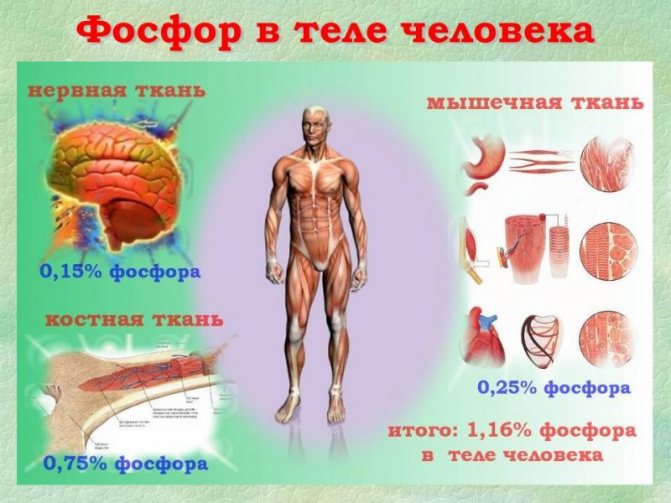Indications for the study
It is recommended to take a blood test for phosphorus in the following cases:
- various pathologies of bone tissue;
- dysfunction of the parathyroid glands;
- chronic kidney problems;
- abnormal vitamin D levels.
If deviations from the norm are minor, clinical manifestations are usually absent. To obtain a more complete picture of the patient's condition, phosphorus and calcium levels are usually determined simultaneously. The results of these two analyzes make it possible to reliably assess the state of mineral metabolism.
It is also recommended to undergo examination if you have the following symptoms:
- muscle spasms or weakness;
- fatigue, constant fatigue;
- repeated fractures with minor impact on the bones.
Interaction of phosphorus with other substances
The content and absorption of phosphorus in the body largely depends on the functioning of the thyroid gland and the parathyroid glands located near it, as well as on the functions of the kidneys. Thus, the thyroid gland synthesizes the hormone calcitonin, and the parathyroid glands produce parathyroid hormone, which have a hypophosphatemic effect on the body. In addition, vitamin D is of great importance for the metabolism of phosphorus compounds called phosphates. Calcitriol, a derivative of vitamin D3, has a hyperphosphatemic effect.
One of the most important is the relationship between phosphorus and calcium. Both microelements form insoluble compounds necessary for the formation of bone tissue and are involved in other vital physiological processes. Phosphorus is also the main microelement that ensures the complete absorption of vitamin B3. Thus, it is of great importance for ensuring the normal functioning of the kidneys and heart, saturating cells with oxygen, generating and distributing energy, transmitting nerve impulses and performing basic metabolic processes.
The effectiveness of phosphorus is lost with excessive intake of iron, aluminum and magnesium. At the same time, excess phosphorus disrupts the absorption of magnesium, contributing to the development of migraines, arrhythmias and other disorders of various systems.
The level of phosphorus is regulated through the interaction of parathyroid hormone and vitamin D. This “tandem” ensures the absorption of the microelement in the intestine, its transport from bone tissue and processing in the kidneys. The metabolism of phosphorus can be disrupted due to pathological processes in the parathyroid glands, bone tissue and kidneys.
General information
Phosphorus is required by the body for tissue formation. In addition, this macronutrient is required for the normal functioning of many metabolic processes. The macroelement is found in many foods and is absorbed from them into the gastrointestinal tract. It is present in the body in various compounds. Most of the macroelement is combined with calcium and is part of bone tissue. Approximately 1% of the total macronutrient normally circulates in the bloodstream.
The cause of phosphorus deficiency may be a violation of its absorption mechanisms, kidney dysfunction, poor nutrition, etc. Excessive accumulation of this macroelement in the body is most often associated with kidney pathologies, lack of calcium or its excess in the daily diet.
A slight decrease in the amount of a macronutrient, as a rule, does not lead to the appearance of any symptoms. A significant deficiency can be suspected if the patient experiences symptoms such as confusion and muscle weakness. An excess of a macroelement is characterized by convulsions, possibly muscle numbness or loss of consciousness. The metabolism of phosphorus and calcium is closely related.
Why does phosphorus decrease?
A low level of a trace element in a person’s blood is hypophosphatemia. This phenomenon may be a sign of poor nutrition, anorexia, or lack of vitamin D. A low concentration of a microelement in a person’s blood can be caused by a number of diseases and pathological processes, but in most cases this phenomenon is associated with excessive consumption of alcoholic beverages, in addition, it often occurs in people having drug addiction. Other reasons for the decline are as follows:
- rickets;
- severe vomiting or diarrhea, dehydration;
- gout;
- pregnancy;
- malignant tumors;
- hypercalcemia.
In young children who have not yet turned one year old, a decrease in phosphorus can be caused by an incorrectly selected formula for feeding when the body has not yet adapted.
The main symptoms are fatigue, problems with the musculoskeletal system, muscle pain, persistent illnesses of acute respiratory viral infections, acute respiratory infections, and impaired concentration.
In the absence of bad habits and serious illnesses, low phosphorus levels can be caused by poor nutrition, in which a person does not receive the required amount of the microelement from food. In this case, the concentration of phosphorus can be increased to normal levels by changing the diet
But it is important to understand that this can be done in childhood or adulthood. For people 60 years of age and older, nutrition alone will not be enough to raise microelement levels.
How to normalize the amount of phosphorus in the blood?
If the level of phosphorus in the blood is low, its concentration can be raised to normal levels with the help of a proper diet that increases the amount of the microelement. Your daily diet should include whole grains and protein-rich foods. You can increase the phosphorus content by taking dietary supplements.
Dietary supplements have a number of contraindications if taken in excess, so they can be introduced into the diet only after consultation with a doctor. The dose and course of administration depend on the general condition of the patient, the level of phosphorus in the body and the presence of concomitant diseases.
If high or low levels of a microelement are caused by various diseases, it is necessary first of all to treat them along with dietary adjustments. Taking dietary supplements along with medications should be discussed with your doctor, as serious side effects may occur.
Excessive consumption of phosphorus can lead to an imbalance between this trace element and calcium. And this, in turn, is fraught with the occurrence of bone diseases, which is often expressed in damage to dental tissue, bleeding gums and the development of osteoporosis.
Interpretation of results
In patients over 12 years of age, the macronutrient level should be in the range of 0.81-1.45 mmol per liter. For children of different age groups, their own reference values have been established. To correctly interpret the results, establish an accurate diagnosis and prescribe treatment, you must consult a doctor. The test is not intended for self-diagnosis.
Decreased macronutrient levels
there may be various reasons. These include, for example, uncontrolled use of a number of drugs, hypothyroidism, rickets, hyperparathyroidism, malnutrition, hypokalemia, and alcoholism. Decreased rates are also observed in patients with severe burns.
For children, the macronutrient norm is higher than for adults. Until the age of 12, maintaining its normal level is especially important. A deficiency can cause brittle bones and short stature.
Excess phosphorus
can be caused by kidney and liver diseases and a number of other pathologies. Over time, excess phosphates can be deposited in tissues, causing damage to internal organs.
It must be taken into account that eating food within 2-3 hours before taking blood leads to falsely low results. During the day, the concentration of macroelements in the blood is subject to fluctuations (in the evening it increases). In addition, phosphorus levels are affected by many medications. Therefore, the doctor who will interpret the test results must be informed about the use of medications prescribed by other specialists.
Phosphorus in products

Almost all products contain phosphorus. But the greatest amount of phosphorus is found in products of animal origin. These include meat, fish and poultry, as well as eggs, milk and yoghurts, cheeses prepared on their basis. Entering the body with food, this microelement is mostly absorbed in the form of inorganic compounds. It is noteworthy that phosphorus obtained from animal products is absorbed much more easily than the trace element contained in plant foods.
In terms of quantity, the most phosphorus is contained in dry yeast. Here there are 1290 mg of phosphorus per 100 g of product. Approximately the same amount of microelement is found in wheat bran, pumpkin seeds and a number of other plant products. The second largest amount of phosphorus contained are dairy products. Thus, 100 g of cheese contains approximately 600 mg of microelements. This indicator may vary depending on the type of cheese. Together with 100 g of cottage cheese, the body receives 500 mg of phosphorus, with kefir - 140 mg, and with milk 90 mg. It is worth noting that including dairy products in your daily diet is the best solution, since in addition to phosphorus they contain a large amount of calcium. The third place in terms of quantitative phosphorus content is occupied by fish and seafood. Fish contains a high percentage of phosphorus, calcium, and iron.
As mentioned earlier, phosphorus is found in almost all food products that fill the human daily diet. You can consume up to 5000 mg of this microelement per day without harm to your health.
It is important to take into account that once the substance enters the body, it is not completely absorbed:
- The body receives the most phosphorus from dairy products;
- approximately 60-70% of the microelement comes from eating meat and seafood;
- Of the total phosphorus content in plant foods, only about 20% is absorbed by the body.
When compiling your diet, it is necessary to take into account not only the presence of a sufficient amount of phosphorus in it. Don't forget about calcium
It is important that the amount of calcium entering the body does not exceed the amount of phosphorus. To ensure that the body receives calcium and phosphorus in the optimal amount, you need to choose the right foods for your diet.
The ideal solution is to include fatty cottage cheese, hazelnuts, beets, carrots, and cabbage in the daily menu. Beef liver, walnuts, beans, oatmeal, buckwheat and wheat porridge, as well as black caviar are excellent sources of phosphorus for the body.
The food industry today also actively uses phosphorus. Many of its compounds make it possible to give products a more attractive appearance. Phosphates, for example, are used in sausage production. With their help, manufacturers bind excess liquid in products, ensuring their uniform structure, density and juiciness. The use of phosphates is relevant in the production of canned meat and fish, factory-made butter, margarine, processed cheese and everything that is certainly included in the diet of every modern person. Using various phosphorus compounds, manufacturers can:
- replace acidifiers in sweet sodas, low-alcohol drinks and confectionery products with phosphates;
- avoid the formation of hard crystals in condensed milk;
- eliminate the possibility of lumps forming in powder additives such as milk powder, cocoa, cream, etc.;
- achieve a uniform soft consistency when producing processed cheese curds;
- accelerate the dissolution of dry mixtures in the production of ice cream and other such products;
- increase the preservation of margarine and butter;
- increase the density of canned vegetables and fruits;
- clarify sugar, etc.
Phosphorus is found in excessive quantities in modern industrial products. And this can cause significant harm to health. Normally, the amount of phosphorus and calcium entering the body should be approximately the same. The maximum allowable intake is 1.5 parts P and 1 part Ca. To avoid consuming excessive amounts of phosphorus, the composition of products must be studied very carefully.
In this case, special attention should be paid to the presence in the composition:
- orthophosphoric (phosphoric) acid, designated by code E338;
- sodium phosphates – E339;
- potassium phosphates, presented as additive E340;
- calcium phosphates, indicated on labels as E341;
- ammonium phosphates – E342;
- and, finally, magnesium phosphates under the code E343.
Causes of increased phosphorus levels
Hyperphosphatemia is a condition in which there is excessive levels of a substance in the body. The causes of hyperphosphatemia in most cases are quite serious. If phosphorus in the blood is elevated, this indicates that the following pathological conditions may be present:
- diseases leading to the destruction of bone tissue - the main ones are cancerous bone lesions - metastases, sarcoidosis, bone tuberculosis and leukemia;
- cirrhosis of the liver;
- osteoporosis;
- insufficiency of functioning of the parathyroid glands;
- excess vitamin D in the body;
- acidosis;
- acute renal failure;
- chronic renal failure.
If a blood test taken for phosphorus shows its excess, the person may be prescribed additional examinations to identify the cause of the pathology and prescribe appropriate therapy
An increase in phosphorus in the blood is almost never without cause, therefore, when a disorder is detected, it is very important to undergo a full examination
Where it is contained and why it is useful to know about it
The macroelement is one of the most important participants in the formation of various tissues; it accounts for 1% of our body weight (in adults, there is an average of 500-700 grams). Its highest concentration is typical for teeth and bones. But it is present almost everywhere - in muscles, tendons, blood vessels, nerves, fatty tissue, blood plasma.
Phosphorus (P) is found in various compounds that perform different functions. For example, phospholipids (consisting of phosphoric acid, polyhydric alcohols and fatty acids) are involved in the construction of the cell membrane. It is these elements that can restore damaged areas of the skin, liver, brain and other organs. If these lipids are not enough, then regeneration processes slow down significantly and intercellular metabolism is disrupted.

Phosporus also combines with proteins and other macronutrients. With its participation, proteins, enzymes, nucleic acids and other substances necessary for normal life are formed. P levels directly affect calcium absorption, which determines the condition of bones and teeth. The balance of chemical elements is very important for health, metabolic rate and quality of life.
Diagnostics
Since the leading cause of hyperphosphatemia is terminal chronic renal failure, patients with this electrolyte disorder are most often under the supervision of nephrologists. During a general examination of the patient, attention is paid to traces of scratching on the skin, the presence of subcutaneous nodes that are hard on palpation, and identification of signs of hidden tetany - Trousseau and Chvostek symptoms.
Help in recognizing this condition is provided by anamnestic information - diagnosed chronic renal failure, surgery on the thyroid or parathyroid glands. The level of phosphorus is examined in the serum using a biochemical analysis. Differential diagnosis is carried out to establish the etiological factor. For this, as well as to confirm the diagnosis, the following examination is prescribed:
- Laboratory research
. In a biochemical blood test, an increase in the concentration of urea and creatinine is often noted, and almost always a decrease in the level of ionized calcium; less often, a shift in pH to the acidic side. For kidney diseases, the glomerular filtration rate is calculated. - Screening for primary hypoparathyroidism.
In patients, a decrease in the content of parathyroid hormone is detected in the blood, and increased excretion of calcium in the urine. Ultrasound reveals atrophy or absence of the parathyroid glands. Testing for genetic forms of hypoparathyroidism may be needed. - Densitometry.
Osteodensitometry (DEXA) shows a decrease in bone mineral density (T-score from -1.0 and below). - Echography.
Ultrasound of the kidneys in some patients reveals stones in the renal pelvis. Ultrasound of the periarticular tissues shows calcifications. - CT scan.
CT scans of the brain can sometimes visualize calcifications in the basal ganglia. - ECG.
With severe hypocalcemia, the electrocardiogram reveals a prolongation of the QT interval and tachycardia of the “pirouette” type.

Ultrasound of the parathyroid glands










